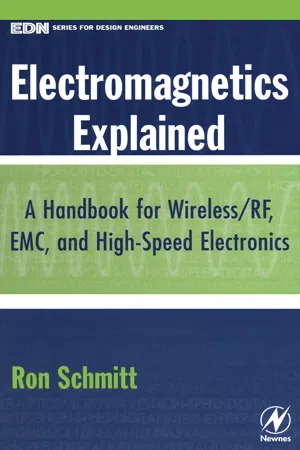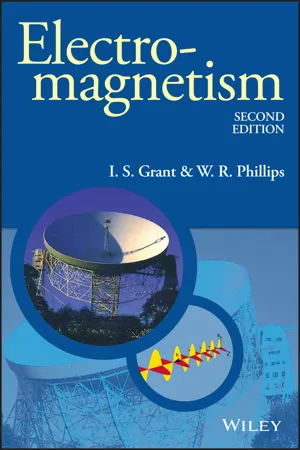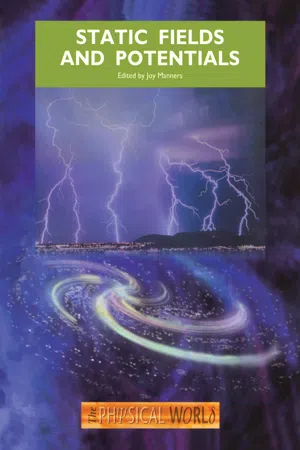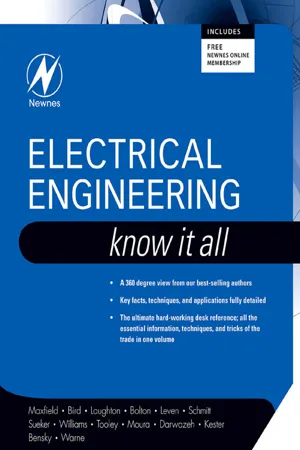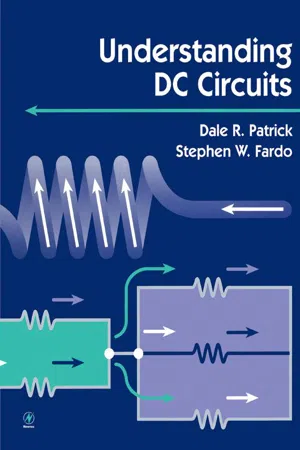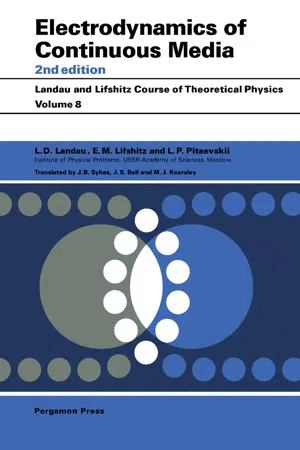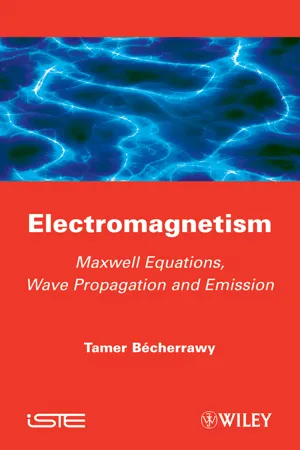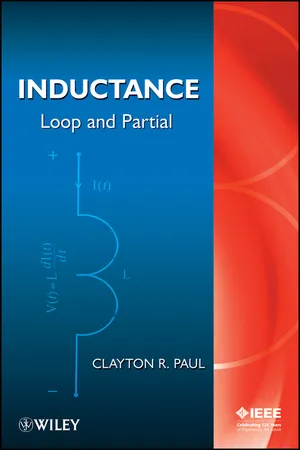Physics
Magnetic Field of a Current-Carrying Wire
The magnetic field of a current-carrying wire refers to the region around the wire where a magnetic force is exerted. When an electric current flows through a wire, it generates a magnetic field around the wire according to the right-hand rule. The strength and direction of the magnetic field depend on the magnitude and direction of the current.
Written by Perlego with AI-assistance
Related key terms
Related key terms
1 of 4
Related key terms
1 of 3
12 Key excerpts on "Magnetic Field of a Current-Carrying Wire"
- eBook - ePub
Electromagnetics Explained
A Handbook for Wireless/ RF, EMC, and High-Speed Electronics
- Ron Schmitt(Author)
- 2002(Publication Date)
- Newnes(Publisher)
In fact, all magnetic fields are generated indirectly by moving electric charges. It is a fundamental fact of nature that moving electrons, as well as any other charges, produce a magnetic field when in motion. Electrical currents in wires also produce magnetic fields because a current is basically the collective movement of a large number of electrons. A steady (DC) current through a wire produces a magnetic field that encircles the wire, as shown in Figure 3.1. Figure 3.1 Magnetic field lines surrounding a current-carrying wire. A single charge moving at constant velocity also produces a tubular magnetic field that encircles the charge, as shown in Figure 3.2. However, the field of a single charge decays along the axis of propagation, with the maximum field occurring in the neighborhood of the charge. The law that describes the field is called the Biot-Savart law, named after the two French scientists who discovered it. Figure 3.2 Magnetic field lines surround a moving electron. It is interesting to note that if you were to move along at the same velocity as the charge, the magnetic field would disappear. In that frame of reference, the charge is stationary, producing only an electric field. Therefore, the magnetic field is a relative quantity. This odd situation hints at the deep relationship between Einstein’s relativity and electromagnetics, which you will learn about in detail in Chapter 6. The magnetic field direction, clockwise or counterclockwise, depends on which direction the current flows. You can use the “right hand rule” for determining the magnetic field direction. Using Figure 3.3 as a guide, extend your hand flat and point your thumb in the direction of the current (i.e., current is defined as the flow of positive charge, which is opposite to the flow of electrons). Now curl the rest of your fingers to form a semicircle - eBook - ePub
- I. S. Grant, W. R. Phillips(Authors)
- 2013(Publication Date)
- Wiley(Publisher)
The field is cylindrically symmetrical, and its magnitude is inversely proportional to the perpendicular distance from the wire. The direction of the field at any point is perpendicular to both the wire and the perpendicular from the point to the wire. The field lines are circles, and the direction of the arrows on the circles is given by the right-hand screw rule. This rule says that the circles go round in the direction the threads of a right-hand screw would rotate if it were screwed in the direction of the current. Figure 4.8 shows the magnetic field lines from a small loop of wire carrying a current. (The leads carrying the current into and out of the loop are close together so that their magnetic effects cancel. They are not drawn.) The field from the small current loop is axially symmetrical, i.e. it is independent of the azimuthal angle with respect to the axis of the coil. This means that a map of the field lines would look the same for any plane containing the axis of the coil. An important result from such field mapping exercises is that at distances from the loop large compared with the dimensions of the loop, the magnetic field varies in the same way as the electric field of an electric dipole. There is one obvious feature of the field lines on Figures 4.7 and 4.8 that is shared by the magnetic field lines arising from any current distribution. The lines of the field B are continuous. Unlike electrostatic field lines, lines of the field B have no beginning and no end. This means that there are no free ‘magnetic charges’ or ‘magnetic poles’, a fact which has important consequences for all of electromagnetism. Let us write this simple experimental fact in the form of a convenient mathematical equation. Consider a closed surface S around a volume V. Since the lines of the field B are continuous, as many lines enter the volume V as leave it. This means that the total outward flux of the field B over the surface S is zero, Figure 4.7 - eBook - ePub
- Joy Manners(Author)
- 2020(Publication Date)
- CRC Press(Publisher)
4.27 The three points referred to in Question 4.8. The current in the wire is flowing in the direction indicated by the arrow. The wire and the three points all lie in the same plane.Figure 4.28 A rough approximation to the magnetic field of a circular loop of wire carrying a steady current. A more accurate representation of the field is given in Figure 4.29 .To work out roughly what we might expect, imagine taking the long straight wire of Figure 4.26 and bending it into a circle. At points very close to the wire, the field lines will be concentric circles — at least to the extent that the influence of other parts of the wire can be ignored — as shown in Figure 4.28 . Notice that in the centre of the wire loop, the fields due to each individual part of the wire reinforce one another: all the field lines point downwards through the middle of the loop. This is important from a practical point of view because it provides us with a way to generate a relatively large magnetic field in that region.Of course, in a full calculation the points on the wire cannot be considered in complete isolation, and the pattern of field lines sketched in Figure 4.28 is therefore only an approximate representation. To obtain a more accurate representation, it is necessary to add vectorially all the magnetic fields created by the various parts of the wire, and the true field pattern is shown in Figure 4.29. Calculation predicts that the magnetic field strength at the centre of the loop will be4.5B centre=μ 0i2 Rfor a circular current loopwhere i is the current and R is the radius of the loop. (Remember, we have, in this context, chosen the directions such that i - eBook - ePub
- Ali Mehrizi-Sani(Author)
- 2024(Publication Date)
- CRC Press(Publisher)
It shows that if the conductor is held in the right hand with the thumb pointing in the direction of the current flow, the fingers then point in the direction of the magnetic field around the conductor. Thus, the conversion of energy between mechanical and electrical forms is achieved through magnetic fields. Figure 3.2b shows the magnetic fields around a conductor carrying current toward the reader and away from the reader, respectively. In the figure, the symbol “dot in a circle” denotes a cross-sectional view of a conductor carrying current toward the reader, while the symbol “+ in a circle” denotes the current flowing away from the reader. Figure 3.2d illustrates the magnetic field around a coil made up of two parallel conductors. Similarly, Figure 3.2e and f shows the magnetic fields around a coil made up of four conductors all carrying current away from the reader and toward the reader, respectively. _________________ 1 The phenomenon of magnetism has been recognized since 600 BC (by the ancient Greeks). However, the first experimental work was performed in the sixteenth century by the English physician, Gilbert, who discovered the existence of a magnetic field around Earth. Also, Oersted recognized that current-carrying conductors could have magnetic effects. Further studies, done by Ampère, on the magnetic field around current-carrying loops, led to the theory of magnetism to a great extent - eBook - ePub
Introduction to Electromagnetism
From Coulomb to Maxwell
- Martin J N Sibley(Author)
- 2021(Publication Date)
- CRC Press(Publisher)
Figure 3.3b shows why this is so.) In addition, there will be an equal and opposite force on the north pole due to the field surrounding the wire.FIGURE 3.3 (a) Magnetic field produced by a current-carrying wire and (b) plan view of wire/magnetic field.Let us try to find the magnetic field strength, δH 1 , at the north pole, due to the current element formed by I and dl . As we have just discussed, the current element produces a force on the north pole, and the north pole will produce an equal and opposite force on the current element. If we can find these two forces, and then equate them, we should get an expression for the magnetic field strength generated by the wire.Let us initially consider the field at dl due to the imaginary north pole of strength p N . As this north pole is a point source, it emits magnetic flux in a radial direction. Thus, we can write the flux density asDirect experimental measurement shows that the force on a current-carrying conductor placed in a magnetic field is given by(3.8)B N=rp N4 πr 2F = B I l(3.9)where B is the flux density of the magnetic field in which the wire is placed, I is the current flowing through the wire and l is the length of the wire. (We can intuitively reason that this equation is correct by noting that powerful electric motors require a large electric current and contain a large amount of wire – they are very heavy!)By combining Equations (3.8) and (3.9), we find that the force on the element dl due to the field emitted by the north pole isd F =(3.10)I d lp N4 πr 2Let us now turn our attention to the force on the north pole produced by the current element. The current element formed by the current I and the length dl produces a magnetic field strength of dH 1 - eBook - ePub
- Clive Maxfield, John Bird, Tim Williams, Walt Kester, Dan Bensky(Authors)
- 2011(Publication Date)
- Newnes(Publisher)
Biot-Savart law , named after the two French scientists who discovered it.Figure 21.2 Magnetic field lines surround a moving electronIt is interesting to note that if you were to move along at the same velocity as the charge, the magnetic field would disappear. In that frame of reference, the charge is stationary, producing only an electric field. Therefore, the magnetic field is a relative quantity. This odd situation hints at the deep relationship between Einstein’s relativity and electromagnetics.The magnetic field direction, clockwise or counterclockwise, depends on which direction the current flows. You can use the “right hand rule” for determining the magnetic field direction. Using Figure 21.3 as a guide, extend your hand flat and point your thumb in the direction of the current (i.e., current is defined as the flow of positive charge, which is opposite to the flow of electrons). Now curl the rest of your fingers to form a semicircle. The magnetic field will follow your fingers, flowing from your hand to your fingertips, or in other words, the arrow tips of the field will be at your fingertips.Figure 21.3 The right hand rule: the magnetic field (B ) curls like the fingers of the hand around the current (I ), which points in the direction of the thumb21.2 Magnetic Dipoles
Now, consider a current that travels in a loop, as shown in Figure 21.4 . The magnetic field is a toroidal (donut-shaped) form. The magnetic field of this device flows out of one side and back in the other side. Although the field lines still form closed loops, they now have a sense of direction. The side where the field lines emanate is called the north pole , and the side they enter is called the south pole . Hence, such a structure is called a magnetic dipole . Now if a wire is wound in many spiraling loops, a solenoid like that shown in Figure 21.5 - eBook - ePub
- A. L. Stanford, J. M. Tanner(Authors)
- 2014(Publication Date)
- Academic Press(Publisher)
m on the wire is given by(16-15)F m= i l × B(16-15)where l is a vector that has a magnitude equal to the length l of the wire and is in the direction of the current arrow (the direction of the flow of positive charge) in the wire. Thus Equation (16-15) follows from Equation (16-1) , F m = q v × B ; either equation may be used as a basis for a measurement of the magnetic field B .E 16.11
A 12-cm segment of wire carries a current of 8.0 A in the positive x direction in a region where B is given by 0.25 T. Calculate the magnetic force on this wire segment.Answer: 0.24 NEach infinitesimal segment dl of a current-carrying wire in a magnetic field B experiences a magnetic force dF m given by(16-16)dF m= i dl × B(16-16)where i is the current in the wire and dl is a vector representing an infinitesimal length of the wire in the direction of the current arrow. The quantity i dl is a current element of the wire. We may calculate the total force on a current-carrying wire by integrating Equation (16-16) over all the current elements that compose the wire:(16-17)F m= i∮dl × B(16-17)E 16.12
Show that if B is constant, the net magnetic force acting on any closed current loop is equal to zero. (Hint: Here because B is constant.)16.2 The Biot-Savart Law
To this point we have considered the effects of magnetic fields on moving charges. Now we will consider how moving charges themselves produce magnetic fields—how moving charges are the sources of magnetic fields. The law of Biot and Savart is the result of experimental observation: It relates the magnetic field at a point in space to the source of that field, a current element. - eBook - ePub
- Michael M. Mansfield, Colm O'Sullivan(Authors)
- 2020(Publication Date)
- Wiley(Publisher)
19 Interactions between magnetic fields and electric currents; magnetic materials AIMS to understand the forces experienced by electric currents in magnetic fields to show how such forces may be utilised in instrument design to study the forces on charges which are moving in magnetic fields to investigate the nature of magnetic materials 19.1 Forces between currents and magnets Consider the situation shown in Figure 19.1. The current I in the wire produces a magnetic field at the location occupied by a pole of strength p. The contribution to the force on p due to the current I flowing in the element is directed perpendicularly to the page inwards and, from Equation (18.14), is given by From Newton's third law, there will be an equal and opposite force on the element due to the influence of the pole p, which is given by (19.1) and is directed perpendicularly to the page outwards. Let us now change the origin relative to which r is defined so that it is located at the pole p rather than at the element, that is in Equation (19.1). The force on the element due to the pole p is then given by Figure 19.1 The force exerted on the current element by the magnetic pole p is directed perpendicularly to the page outwards if p is an N pole. Figure 19.2 The force on the current element due to a magnetic field of flux density B at the element is given by Equation (19.2). Figure 19.3 The force on a straight length l of wire in a uniform magnetic field of flux density B is IlB sin θ, where I is the current in the wire and θ is the angle the wire makes with the direction of the magnetic field. Now the term in this equation is the magnetic flux density B at the element due to the pole p (recall Equation (18.15)) and hence we may write (19.2) This result describes equally well the force on a current element due to any source of magnetic field since, in the limit, the flux density at the element will be the same as that due to an equivalent single pole - eBook - ePub
- Dale Patrick, Stephen Fardo(Authors)
- 1999(Publication Date)
- Newnes(Publisher)
Fig. 4-4d . The needle does not point toward the conductor. When current flows in the opposite direction, the compass polarities reverse. The compass needle aligns itself tangentially to the conductor.Magnetic Field Around a Coil
The magnetic field around one loop of wire is shown in Fig. 4-5 . Magnetic flux lines extend around the conductor as shown. Inside the loop, the magnetic flux is in one direction. When many loops are joined together to form a coil, the magnetic flux lines surround the coil as shown in Fig. 4-6 . The field around a coil is much stronger than the field of one loop of wire. The field around the coil is the same shape as the field around a bar magnet. A coil that has an iron or steel core inside it is called an electromagnet. A core increases the magnetic flux density of a coil.Figure 4-5 Magnetic field around a loop of wire.Figure 4-6 Magnetic field around a coil, (a) Coil of wire showing current flow, (b) Lines of force around two loops that are parallel, (c) Cross section of coil showing lines of force.Self-Examination
1. A substance that has its molecules arranged at random is_____.2. A substance that has its molecules aligned is_____.3. The space surrounding a magnet, in which the magnetic force acts, is called the_____.4. Magnetic lines of force are directed from the _____ pole to the _____ pole.5. Like magnetic poles _____, unlike poles_____.Answers
1. Nonmagnetic2. Magnetic3. Magnetic field4. North, southElectromagnets
An electromagnet is produced when current flows through a coil of wire, as shown in Fig. 4-7 . The north pole of a coil of wire is the end where the lines of force come out. The south polarity is the end where the lines of force enter the coil. This is like the field of a bar magnet. To find the north pole of a coil, use the left -hand rule for polarity , as shown in Fig. 4-8 - eBook - ePub
- L D Landau, J. S. Bell, M. J. Kearsley, L. P. Pitaevskii, E.M. Lifshitz, J. B. Sykes(Authors)
- 2013(Publication Date)
- Pergamon(Publisher)
J/c. Hence the potential changes by this amount on each passage round a contour enclosing a linear current, i.e. it is a many-valued function.If the currents lie in a finite region of space (and μ = 1 everywhere), the vector potential of the magnetic field at a great distance from the conductors isA = M × R/(30.16)R 3,(30.16)whereM =(30.17)∫r × jd V / 2 c(30.17)is the total magnetic moment of the system.†For a linear current, this becomesM = J∮/2 c ,r × d 1and can be transformed into an integral over a surface bounded by the line of the current. The product is equal in magnitude to the area of the triangular surface element formed by the vectors r and d1 . The vector ∫df is independent of the particular surface (bounded by the current) over which it is taken. Thus the magnetic moment of a closed linear current isM = J(30.18)∮ df/ c .(30.18)In particular, for a plane closed linear current the magnetic moment is simply JS/c , where S is the area of the plane enclosed by the current.To conclude this section, we may briefly discuss the energy flux in a conductor. The energy dissipated as Joule heat in the conductor is derived from the energy of the electromagnetic field. In a steady state, the equation of continuity which expresses the law of conservation of energy is - eBook - ePub
Electromagnetism
Maxwell Equations, Wave Propagation and Emission
- Tamer Becherrawy(Author)
- 2013(Publication Date)
- Wiley-ISTE(Publisher)
BThus, the field of the sphere tends to 0 like R as R → 0. This shows that the field of a volume current distribution is finite and continuous.The singularities and the discontinuities of B are due to the zero limit of the diameter of the line of current and the thickness of the sheet of current. In reality, the macroscopic bodies always have finite dimensions. At the microscopic level, we must distinguish between the microscopic field , which undergoes fluctuations and become infinite at the position of point charges, and the macroscopic field , which is regular and continuous (see the section 2.8 ).6.10. Magnetic energy of a circuit in a field BWe have seen that a uniform field B exerts a moment of force ΓM = × B on a rigid circuit carrying a current I . Thus, |ΓM | = B sin θ, where θ is the angle that makes with B. If the circuit is free to rotate around a point O , it may rotate about an axis whose unit vector u is parallel to ΓM (thus, orthogonal to and B). The circuit is in equilibrium if ΓM = 0, thus θ = 0 ( pointing in the direction of B) or θ = π ( pointing in the opposite direction to B). We may verify that the position θ = 0 is stable, while the position θ = π is not. The work of the magnetic forces in the rotation of the circuit about u - eBook - ePub
Inductance
Loop and Partial
- Clayton R. Paul(Author)
- 2011(Publication Date)
- Wiley-IEEE Press(Publisher)
z direction. The magnetic flux density of a current of infinite length is finite and given byFrom the relation B = ∇ × A in cylindrical coordinates, A is related to B asThis is because the B field has only a ϕ component, and the current and resulting vector magnetic potential is directed in the z direction. Integrating this, we obtainwhere C is a constant of integration. However, when we are using B = ∇ × A to determine the B field for an infinite-length current by first determining A, we can ignore the integration constant C because we differentiateAzin order to determineBϕ .Hence, for a current of infinite length we may assume a form ofAzto be(2.53)EXAMPLEDetermine the vector magnetic potential at a distance r from the center of a current of length L and on a line perpendicular to its midpoint as shown in Fig. 2.23 . Then determine the magnetic field B from that result. Although steady (dc) currents must form closed loops, we again use the solutions for currents of finite length to construct, by superposition, the magnetic fields of closed current loops (see the discussion in Section 2.9). Hence, determining the vector magnetic potential for currents of finite length is useful for that purpose.FIGURE 2.23 . Vector magnetic potential of a current.The problem again fits a cylindrical coordinate system (see the Appendix for a discussion of the cylindrical coordinate system). From (2.52c) and Fig. 2.23 we see that since the current is directed solely in the z direction, the vector magnetic potential will be parallel to it at all points and directed in the z direction also. From (2.52c)
Index pages curate the most relevant extracts from our library of academic textbooks. They’ve been created using an in-house natural language model (NLM), each adding context and meaning to key research topics.
Explore more topic indexes
Explore more topic indexes
1 of 6
Explore more topic indexes
1 of 4
